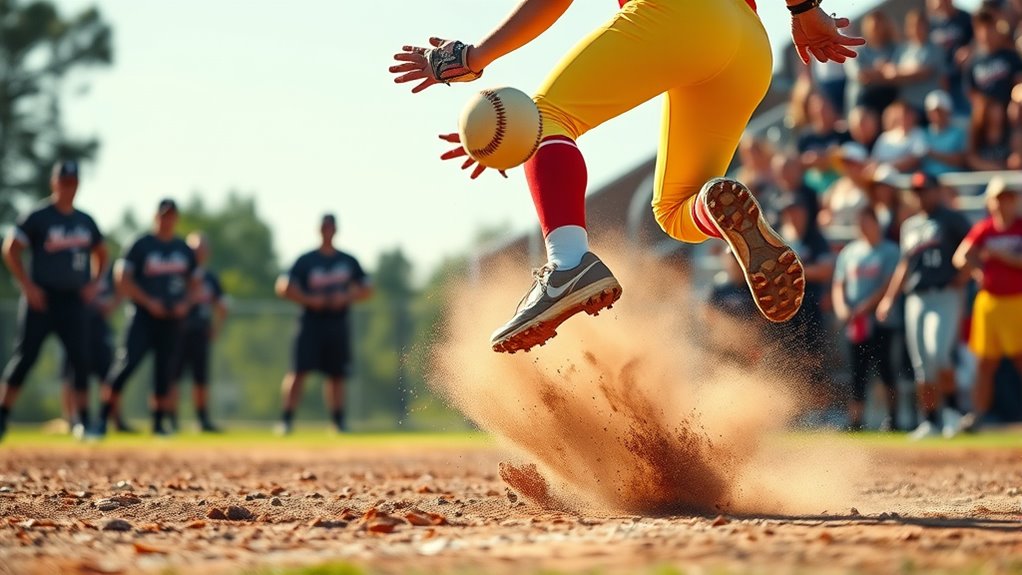The infield fly rule is a safety measure used to prevent fielders from intentionally dropping easy pop-ups to gain an unfair advantage, like forcing double plays. It applies when there are runners on first and second or bases loaded, with fewer than two outs, and a fair, catchable fly ball is hit in the infield. Knowing when and how it works helps you stay aware of game strategy—if you want to understand all the details, keep going.
Key Takeaways
- The infield fly rule prevents fielders from intentionally dropping easy pop-ups to force unfair double plays.
- It activates with fewer than two outs and runners on first and second or bases loaded.
- The umpire signals the rule when a catchable fly ball meets specific criteria for infielders.
- Runners must stay on bases until the ball is caught; the rule protects baserunners from deception.
- Proper understanding ensures fair play, game integrity, and helps players and spectators recognize the rule’s application.
The Origin and Purpose of the Infield Fly Rule

The infield fly rule was created to prevent fielders from intentionally dropping easy pop-ups to force runners into double or triple plays. Its history background dates back to the early 20th century when teams exploited the rule to gain unfair advantages. Over time, the rule evolved through various rule changes, making it clearer and more consistent. Initially, the focus was on discouraging intentional drops to manipulate runners, but as baseball developed, officials clarified when the rule applies and under what circumstances. The main purpose remains to protect baserunners from deceptive plays while maintaining fair play. This evolution has helped preserve the game’s integrity, ensuring that the infield fly rule serves its original intent: preventing strategic abuses and promoting sportsmanship on the field. Additionally, understanding the official guidelines for when the rule is enforced helps ensure fair play during crucial game moments.
When Does the Infield Fly Rule Come Into Play?

You’ll see the infield fly rule come into play when there are fewer than two outs, and there are runners on first and second or bases loaded. The umpire signaling the rule will be clear—raising both arms overhead, indicating an infield fly. The fielder positioning is vital here; infielders must be alert and ready to catch the pop-up. Once the umpire signals, the batter is automatically out if the ball is caught, regardless of whether the fielder makes the catch or not. This rule helps prevent infielders from intentionally dropping easy catches to force double plays. Keep in mind, it applies only in specific situations, and the umpire’s signaling confirms when the infield fly rule is in effect, making sure everyone knows the play is protected. Additionally, understanding the infield fly rule helps players and fans appreciate the strategic aspects of the game.
The Exact Conditions: Bases, Outs, and Batter Count

The infield fly rule applies only under specific conditions related to the game’s runners, outs, and batter count. You need to be aware of when to call or recognize the rule, based on the following:
- There must be no fewer than first and second, or first, second, and third bases occupied.
- There are two outs on the board.
- The batter hits a fair fly ball that can be caught with ordinary effort.
Field positioning is key, as players must communicate clearly to avoid confusion. This includes alerting teammates when the rule is in effect and adjusting positions accordingly. Proper player communication ensures everyone knows whether an infield fly is called, preventing unnecessary disputes. Staying alert to these conditions helps you make the right decision quickly and maintain game flow.
What Constitutes an Infield Fly?
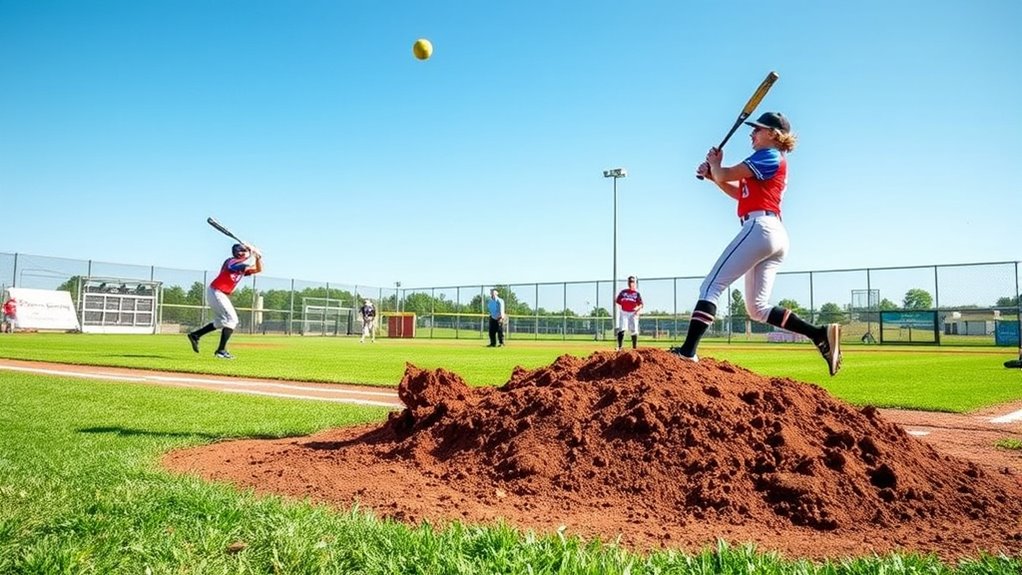
You need to understand what conditions trigger an infield fly, starting with the runners on base. The ball must be hit in the infield and have a certain height, usually pop-ups or fly balls that stay close to the infield area. If these criteria are met, the umpire can call an infield fly to prevent the runners from gaining an unfair advantage.
Runners on Base
An infield fly occurs when there are runners on first and second or bases loaded with fewer than two outs, and a fair fly ball is hit that can be caught easily by an infielder. The rule aims to prevent the defense from intentionally dropping the ball to turn a double play. When this happens, the umpire signals the infield fly, alerting all players. Runners must stay on their bases, as the batter is automatically out, regardless of whether the ball is caught. Proper base running is essential, so runners don’t attempt to advance prematurely. The umpire’s signals are vital, especially in crowded situations. Keep in mind:
- Runners on first and second, or bases loaded, with less than two outs
- The ball is in fair territory and catchable
- Players must stay on their bases until the ball is caught
- Understanding the rules helps players and coaches avoid confusion during critical plays.
Batted Ball Criteria
A batted ball qualifies as an infield fly when it is a fair fly ball that can be easily caught by an infielder from a reasonable position. The umpire decision is vital here; they determine if the ball meets this criterion based on the ball’s trajectory and the infielder’s ability to catch it without extraordinary effort. Rule enforcement relies on the umpire’s judgment to call the infield fly correctly, avoiding confusion during fast-paced plays. The ball must be hit in fair territory and be high enough for the infielder to make a routine catch. If the umpire decides the ball fits these criteria, the infield fly rule is invoked, preventing the batter from unfairly influencing the outcome of the play. Proper application of this rule depends on clear communication and the umpire’s understanding of infield fly criteria.
How the Rule Protects the Offensive Team
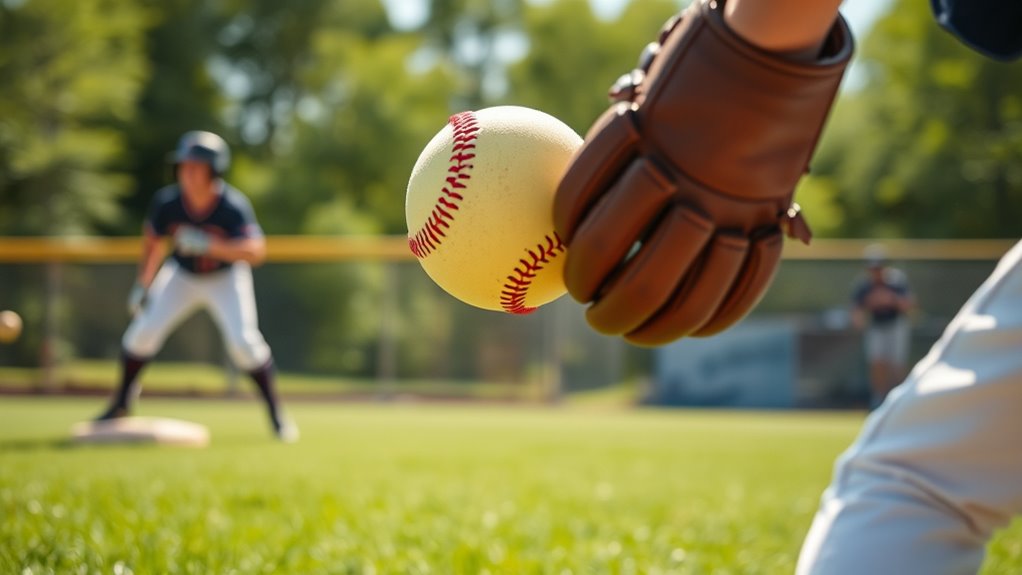
The infield fly rule protects the offensive team by preventing the defense from intentionally dropping a routine pop-up to turn a double or triple play. Without this rule, fielders could deliberately let the ball drop, forcing runners into double plays and unfairly ending innings. This safeguard encourages honest play and maintains fairness. It also influences hitting mechanics and coaching strategies by making batters more confident to swing at questionable pitches, knowing the rule will safeguard them from unfair double plays. Additionally, it prompts players to develop better situational awareness and communication. Recognizing the importance of the rule’s fairness can help teams better understand their strategic options during critical moments.
The Role of the Umpire in Calling the Infield Fly

As an umpire, you have the vital job of making the final call on whether an infield fly should be called. Your judgment powers guarantee that the rule is applied fairly and accurately based on the situation. Knowing the clear criteria helps you make quick, confident decisions that protect the integrity of the game. Being aware of official rules and procedures ensures consistency and fairness in your calls.
Umpire’s Judgment Power
Umpires hold the critical responsibility of making the final call on whether the infield fly rule applies, and their judgment is essential in guaranteeing the correct enforcement of the rule. Their role relies heavily on umpire discretion and rule interpretation during fast-paced plays. You must quickly assess factors such as the number of runners, the ball’s position, and the fly’s catchability. Umpires consider:
- The difficulty level of catching the ball
- The runners’ positions and potential for advancing
- Whether the ball is pop-up in the infield or outfield
This decision requires sharp judgment, balancing strict rule interpretation with real-time observations. Your ability to accurately apply the rule under pressure ensures fair play and clear communication with players and coaches. Additionally, understanding the lifestyle context of game situations can influence decision-making and uphold the integrity of the game.
Clear Call Criteria
When applying the infield fly rule, umpire’s judgment must be guided by clear, consistent criteria to guarantee fair play. To do this, you rely on specific umpire signals, such as raising the hand or pointing to the infield, to communicate the call clearly. These signals help verify everyone understands when the rule is in effect, preventing confusion. Your decision depends on observing the batter’s position and the runners’ batting strategies, like whether they’re attempting to advance or stay put. A precise, confident call maintains the flow of the game and upholds fairness. By adhering to these criteria, you ensure that the infield fly is called accurately, allowing players and spectators to trust the umpire’s judgment and the integrity of the game. Additionally, understanding the Kia Tuning options can be useful for players who want to enhance their vehicle’s performance for better on-field mobility.
Common Misunderstandings About the Infield Fly
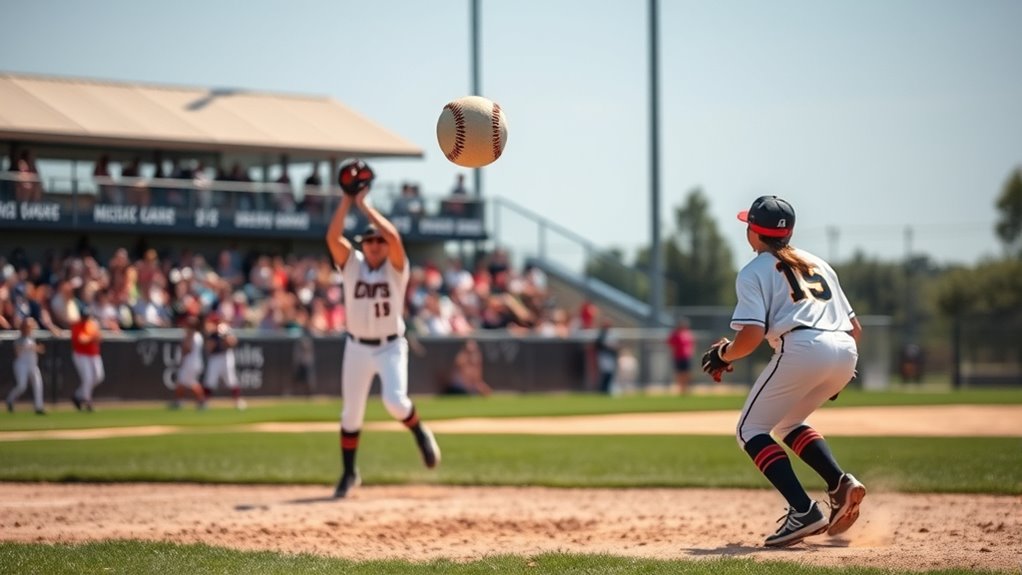
Many people mistakenly believe the infield fly rule is simply about automatically declaring an out whenever a fly ball is caught with runners on base. In reality, it’s more nuanced, involving specific field positioning and umpire signals. The umpire must determine if the fly is catchable and signal the play accordingly. Misunderstandings often arise because players think the rule applies to all fly balls, regardless of how the fielders are positioned. Additionally, foraging range influences how players interpret their positioning and responsibilities on the field.
- Field positioning matters: the fielder must be in an infield position, not just any outfielder.
- Umpire signals clarify the call, but players sometimes ignore or misinterpret them.
- The rule isn’t triggered by a pop-up in the outfield or a routine fly, only those that threaten to deceive runners.
Examples of Infield Fly Situations in Softball Games
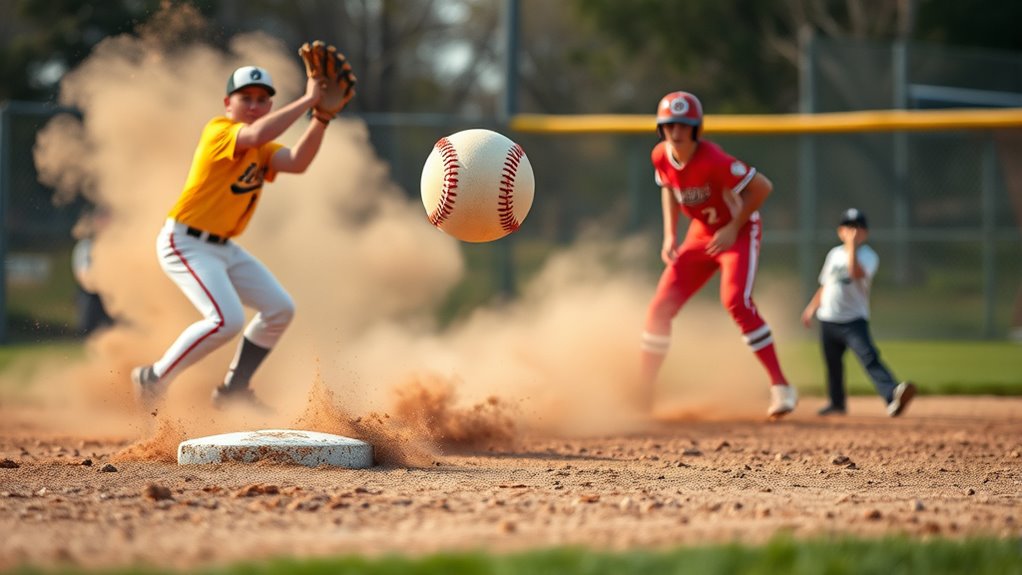
Understanding infield fly situations can help you anticipate when the rule applies. For example, imagine there’s a runner on first with no outs, or the bases are loaded with two outs and a bunt play is underway. These scenarios highlight common instances where the infield fly rule might come into play during softball games.
Runner on First Only
Have you ever wondered how the infield fly rule applies when there’s a runner on first only? In softball, unlike baseball vs softball, the rule remains the same: the umpire declares the batter out if a catchable fly ball is hit with fewer than two outs and a runner on first. This prevents the fielder from intentionally dropping the ball to turn a double play. Understanding the rules of softball ensures players and fans are clear on how the game is played and officiated. When this situation occurs, fielding strategies shift:
- The infielder positions themselves to catch the ball confidently, avoiding unnecessary throws.
- Outfielders prepare for a quick catch and relay to prevent runners from advancing.
- The batter’s team must stay alert, knowing the runner on first might attempt to take advantage of a dropped ball if the rule isn’t called.
Bases Loaded, No Outs
When the bases are loaded with no outs, the infield fly rule becomes a essential tool for the defense to prevent runners from advancing easily. Field positioning is critical in this situation; infielders must be alert and positioned to catch high pop-ups without interference. Clear player communication is necessary—outfielders and infielders need to signal and confirm who will make the catch to avoid collisions or drops. By calling the infield fly loudly and coordinating movements, you help guarantee everyone knows their responsibilities. This setup allows the defense to quickly catch the ball and get a force out at any base, preventing runners from taking extra bases or scoring. Proper positioning and communication keep the game under control and uphold the fairness the rule intends.
Two Outs, Bunt Play
With two outs and a bunt attempt, the infield fly rule often comes into play to prevent runners from advancing on a pop-up. When the ball is hit in the infield, the umpire signals the infield fly to alert players and spectators. Your team’s fielding strategy shifts—players must quickly identify who will catch the ball and communicate effectively. As the ball is caught or called an infield fly, runners can stay put, avoiding accidental advancement. Key considerations include:
- Positioning players to cover potential catch zones
- Communicating clearly to avoid misplays
- Reacting swiftly to umpire signaling to execute proper fielding techniques
Understanding these elements helps guarantee the rule is correctly applied, keeping the game fair and smooth. Proper recognition of the infield fly situation is vital for both fielders and umpires during bunt plays with two outs.
Differences Between Softball and Baseball in the Infield Fly Rule
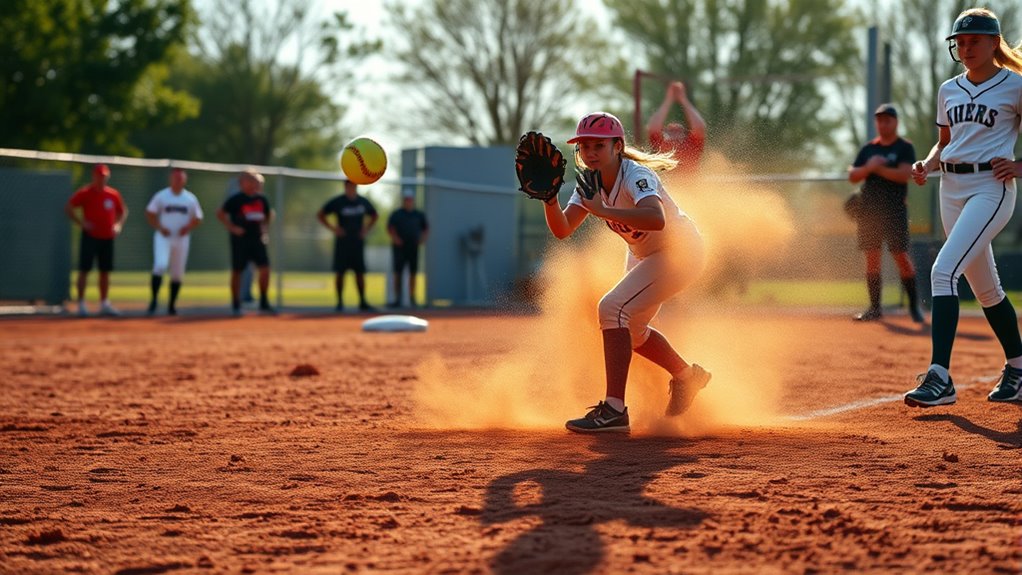
The infield fly rule differs between softball and baseball, primarily in how and when it’s applied. In softball, the rule is often stricter, requiring fielders to be positioned strategically, especially in the shallow infield, to alert players. Player communication is vital; teammates must call out the fly to avoid confusion. In baseball, the rule applies when runners are on first and second or bases loaded with fewer than two outs, regardless of specific field positioning. Softball generally emphasizes quicker reactions and more dynamic fielding, while baseball’s larger field allows different positioning strategies. Understanding these differences helps you recognize when the rule applies and guarantees proper communication among players, preventing unnecessary conflicts and penalties during game play.
Tips for Players to Recognize and Respond to the Infield Fly
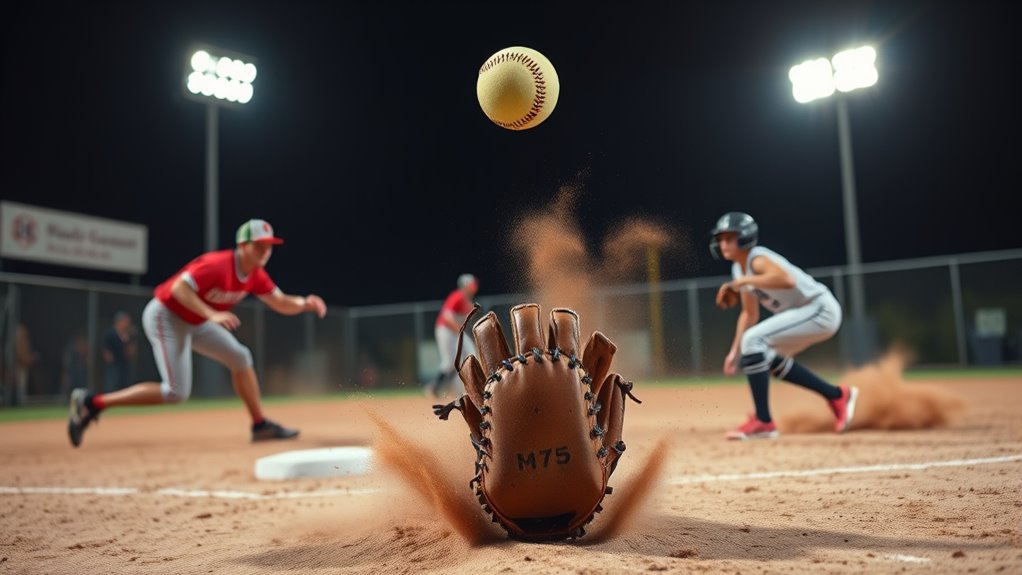
Recognizing the infield fly quickly is essential to responding effectively. Pay attention to umpire signals—when they call “Infield Fly,” you should immediately prepare for a potential catch. Use proper fielding techniques by staying alert and positioning yourself correctly under the ball. Watch for the batter’s and runners’ movements to anticipate the play. To improve your response:
Quickly recognize the infield fly by watching umpire signals and staying alert for the play.
- Focus on maintaining quick, fluid footwork to get into the right position.
- Keep your glove and body ready to catch or quickly transfer the ball.
- Stay aware of umpire signals and calls to avoid confusion during the play.
Practicing these skills sharpens your reaction time and ensures you handle the infield fly confidently, reducing errors and making game-winning plays.
Frequently Asked Questions
Can the Umpire Call an Infield Fly Without the Batter Hitting the Ball?
You might wonder if the umpire can call an infield fly without the batter hitting the ball. Generally, umpire discretion is involved, but the batter must make contact with the ball for the call to be made. If the batter misses or doesn’t swing, the umpire can’t call an infield fly. Batter awareness is key, as the call depends on whether they’ve attempted to hit the ball and the situation on the field.
Does the Infield Fly Rule Apply in Extra Innings or Only Regulation Play?
You might wonder if the infield fly rule applies during extra innings. Typically, it doesn’t—this rule is a regulation play exception. In extra innings, umpires usually don’t call an infield fly because the focus shifts to ending the game quickly. However, rules can vary by league, so it’s always good to check specific league rules or rule exceptions, as some may have different guidelines for these situations.
Can a Player Intentionally Drop the Ball to Deceive the Runners?
You might wonder if players can use deception tactics like intentional drops to trick runners. In softball, intentionally dropping the ball to deceive is considered illegal and can result in the batter being called out or other penalties. The game’s rules aim to prevent trickery that unfairly disrupts play, so you shouldn’t rely on intentional drops as a deception tactic—they’re against the rules and can cost your team.
How Does the Infield Fly Rule Differ in Fastpitch Versus Slowpitch Softball?
In fastpitch softball, the infield fly rule activates with quick bat speed and strategic field positioning, alerting you to a tricky play. It’s designed to prevent easy double plays when runners are on base. Slowpitch, however, relaxes the rule, giving you more flexibility. You must stay alert and adapt to each style’s nuances, knowing that in fastpitch, the stakes are higher, and the rule’s precision keeps the game fair and exciting.
Are There Any Penalties if the Umpire Incorrectly Calls or Misses an Infield Fly?
If the umpire makes mistakes by incorrectly calling or missing an infield fly, there usually aren’t penalty consequences for the mistake itself. However, it’s essential to understand that incorrect calls can affect the game’s outcome, so umpires endeavor for accuracy. If you believe a mistake has been made, you can often request clarification or an appeal, but ultimately, the game depends on the umpire’s judgment, and penalties are rare for missed calls.
Conclusion
Understanding the infield fly rule helps you recognize its importance, anticipate its call, and respond confidently. It prevents unfair plays, promotes fair competition, and keeps the game moving smoothly. By knowing when it applies, what it means, and how to react, you become a smarter player and a better teammate. Embrace the rule, respect its purpose, and stay alert—because knowing the infield fly makes you a stronger, more confident player on the field.
